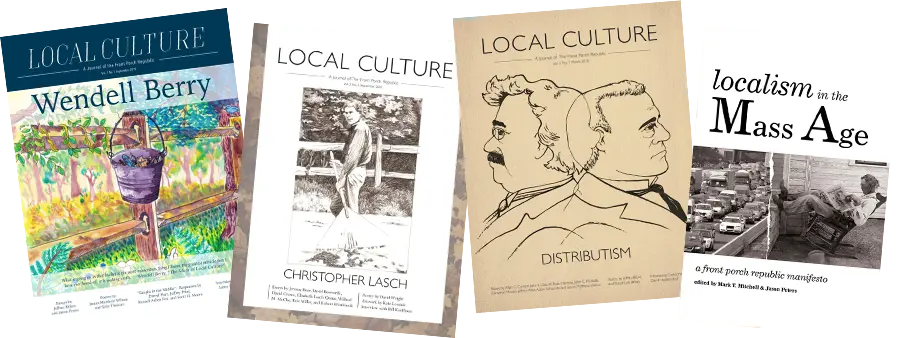A summer evening in Southwest Philadelphia. Porch lights flicker on as dusk settles over narrow rowhouse streets. Music floats from a speaker. Kids ride scooters in the street. Neighbors wave from stoops where they’ve settled in folding chairs. A Buick eases past, gleaming with intention. It could be 1954, or it could be last week.
But not far from here—maybe even on this block—there was a shooting a few months ago.
This is the paradox of place in Southwest Philly. The grief and the gathering. The rupture and the ritual. Here the front porch isn’t just a memory of America’s past. It’s still lived, every evening, in neighborhoods long abandoned by policymakers but still inhabited by thick communities.
Southwest Philadelphia’s grid of rowhomes was built to house a growing working and middle class at the turn of the twentieth century. These homes, placed shoulder-to-shoulder, were intentionally designed to balance affordability with dignity, privacy with proximity. Streets were narrow to encourage foot traffic. Corner stores were embedded into blocks. Churches were interwoven with housing. Schools sat in the heart of neighborhoods, not at their margins.
The front porch—prominent, elevated, and public—was the physical threshold between the domestic and the civic. It invited conversation, observation, accountability, and ease. These weren’t transitional spaces that individuals would quickly cross on their way to private, air-conditioned interiors. They were destinations that drew a home’s inhabitants and neighbors. They were places of pride and performance. The ideal of the self-made American homeowner had an address, and it started with the stoop.
Postwar America redrew the map. Highways split neighborhoods. Suburbs sprawled outward. The GI Bill and FHA-backed loans built a new middle class—but only for some. Redlining ensured that Black families in places like Southwest Philly couldn’t access those same benefits. White residents left with federally subsidized ease. Disinvestment and racial segregation replaced them.
Black families moved into these rowhomes not because of policy support but in spite of it. They inherited the form of the American dream with none of the structural scaffolding. Banks pulled out. Supermarkets fled. Schools were left to decay. But they stayed. They held the block down even as it fractured around them.
Despite decades of disinvestment, a surprising amount of the old fabric holds.
Porches are still used—daily, deeply. Churches remain the nucleus of community life, offering not just worship but evening classes, job training, food distribution, and childcare. Corner stores are more than transactional, they’re relational. And those cars—Buicks, Lincolns, Cadillacs—are still prized, not out of retro irony, but as enduring signals of success and self-respect.
There are block parties in summer. Impromptu festivals with folding tables and grills. Sidewalks become social forums. Despite poverty, despite violence, the built environment continues to generate belonging. The design has outlived the investment, and the culture has outlived the neglect.
Walkability. Medium-density. Mixed-use zoning. “The 15-minute city.” These are the new buzzwords of progressive urban design. But what today’s urbanists seek to recover is exactly what was abandoned, often deliberately, in places like Southwest Philadelphia.
The irony is bitter. We are spending billions trying to recreate what we bulldozed. And the places where it was never destroyed? Many overlook them or pathologize them. Most people see only the poverty here, never the poetry.
This is the American blind spot: the assumption that suffering and strength are mutually exclusive. But here they live side by side. The same street that saw a shooting last week may host a baby shower on Saturday. A funeral procession in the morning, a cookout by evening. The neighborhood doesn’t deny its pain, it absorbs it, and still it gathers. Still it waves. Still it sings.
This isn’t contradiction. It’s cohesion—the hard-won kind. These blocks know how to hold both grief and joy. They know how to mourn and still mow the lawn. The porch, somehow, holds it all.
Policy can support a neighborhood, but it can’t resurrect a culture.
We cannot replicate this through zoning reform alone. Policy can support a neighborhood, but it can’t resurrect a culture. Renewal must start with recognition: that these places still hold value, still model what civic life can look like. That means investing in churches, not just transit. Supporting schools, not just developers. We must honor what is already functioning. The front porch was never just a design feature. It was a worldview. One that said we are part of each other. Some places have never stopped living that truth.
Another evening settles in. A woman sweeps her stoop. A boy with a basketball nods at a neighbor. Gospel music hums from an open window. This is not the past preserved. It’s the present surviving. We keep looking to design the future. Maybe it’s already here—in the places we forgot to bulldoze, among the people we failed to see.
What if the most radical act of city planning is not to build something new, but to attend to what has endured and finally call it good?
Image via Flickr.





1 comment
Brian Miller
What an encouraging piece on the resilience of community in an area I would have over looked.